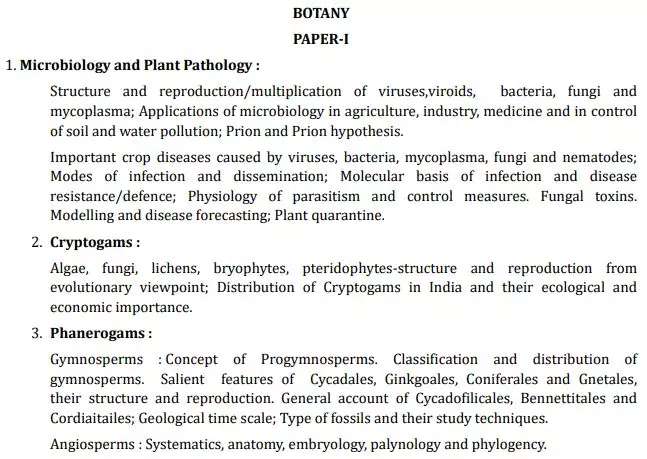‘Botany Syllabus For UPSC Main Examination‘ PDF Quick download link is given at the bottom of this article. You can see the PDF demo, size of the PDF, page numbers, and direct download Free PDF of ‘UPSC Mains Botany Optional Syllabus’ using the download button.
UPSC Optional Botany Paper 1 And 2 Syllabus PDF Free Download

Official UPSC Optional Botany Paper 1 And 2 Syllabus
PAPER‐1
Microbiology and Plant Pathology :
Structure and reproduction/multiplication of viruses,viroids, bacteria, fungi and mycoplasma; Applications of microbiology in agriculture, industry, medicine and in control of soil and water pollution; Prion and Prion hypothesis.
Important crop diseases caused by viruses, bacteria, mycoplasma, fungi and nematodes;Modes of infection and dissemination; Molecular basis of infection and disease resistance/defence; Physiology of parasitism and control measures. Fungal toxins. Modelling and disease forecasting; Plant quarantine.
Cryptogams :
Algae, fungi, lichens, bryophytes, pteridophytes-structure and reproduction from evolutionary viewpoint; Distribution of Cryptogams in India and their ecological and economic importance.
Phanerogams :
Gymnosperms : Concept of Progymnosperms. Classification and distribution of gymnosperms. Salient features of Cycadales, Ginkgoales, Coniferales and Gnetales, their structure and reproduction. General account of Cycadofilicales, Bennettitales and Cordiaitailes; Geological time scale; Type of fossils and their study techniques.
Angiosperms : Systematics, anatomy, embryology, palynology and phylogeny. Taxonomic hierarchy; International Code of Botanical Nomenclature; Numerical taxonomy and chemotaxomomy; Evidence from anatomy, embryology and palynology.
Origin and evolution of angiosperms; Comparative account of various systems of classification of angiosperms; Study of angiospermic families— Mangnoliaceae, Ranunculaceae, Brassicaceae, Rosaceae, Fabaceae, Euphorbiaceae, Malvaceae, Dipterocarpaceae, Apiaceae, Asclepiadaceae, Verbenaceae, Solanaceae, Rubiaceae,
Cucurbitaceae, Asteraceae, Poaceae, Arecaceae, Liliaceae, Musaceae and Orchidaceae. Stomata and their types; Glandular and non-glandular trichomes; Unusual secondary growth; Anatomy of C3 and C4 plants; Xylem and phloem differentiation; Wood anatomy.
Development of male and female gametophytes, pollination, fertilization; Endosperm—its development and function. Patterns of embryo development; Polyembroyony, apomixes; Applications of palynology; Experimental embryology including pollen storage and test-tube fertilization.
Plant Resource Development :
Domestication and introduction of plants; Origin of cultivated plants, Vavilov’s centres of origin. Plants as sources for food, fodder, fibres, spices, beverages, edible oils, drugs, narcotics, insecticides, timber, gums, resins and dyes; latex, cellulose, starch and its products; Perfumery; Importance of Ethnobotany in Indian context; Energy plantations;
Botanical Gardens and Herbaria.
Morphogenesis :
Totipotency, polarity, symmetry and differentiation; Cell, tissue, organ and protoplast culture. Somatic hybrids and Cybrids; Micropropagation; Somaclonal variation and its applications; Pollen haploids, embryo rescue methods and their applications.
PAPER‐II
Cell Biology :
Techniques of cell biology. Prokaryotic and eukaryotic cells—structural and ultrastructural details; Structure and function of extracellular matrix (cell wall) and membranes-cell adhesion, membrane transport and vesicular transport; Structure and function of cell organelles (chloroplasts, mitochondria, ER, dictyosomes ribosomes, endosomes,lysosomes, peroxisomes; Cytoskelaton and microtubules; Nucleus, nucleolus, nuclear pore complex;
Chromatin and nucleosome; Cell signalling and cell receptors; Signal transduction Mitosis and meiosis; molecular basis of cell cycle. Numerical and structural variations in chromosomes and their significance; Chromatin organization and packaging of genome; Polytene chromosomes; B-chromosomes—structure, behaviour and significance.
Genetics, Molecular Biology and Evolution :
Development of genetics, and gene versus allele concepts (Pseudoalleles); Quantitative genetics and multiple factors; Incomplete dominance, polygenic inheritance, multiple alleles; Linkage and crossing over of gene mapping including molecular maps (idea of mapping, function); Sex chromosomes and sex-linked inheritance; sex determination and molecular basis of sex differentiation; Mutations (biochemical and molecular basis);
Cytoplasmic inheritance and cytoplasmic genes (including genetics of male sterility). Structure and synthesis of nucleic acids and proteins; Genetic code and regulation of gene expression; Gene silencing; Multigene families; Organic evolution-evidences, mechanism and theories. Role of RNA in origin and evolution.
Plant Breeding, Biotechnology and Biostatistics :
Methods of plant breeding—introduction, selection and hybridization (pedigree, backcross, mass selection, bulk method); Mutation, polyploidy, male sterility and heterosis breeding. Use of apomixes in plant breeding; DNA sequencing; Genetic engineering—methods of transfer of genes; Transgenic crops and biosafety aspects;
Development and use of molecular markers in plant breeding; Tools and techniques—probe, southern blotting, DNA fingerprinting, PCR and FISH. Standard deviation and coefficient of variation (CV). Tests of significance (Z-test, t-test and chi-square tests). Probability and distributions (normal, binomial and Poisson). Correlation and regression.
Physiology and Biochemistry :
Water relations, mineral nutrition and ion transport, mineral deficiencies Photosynthesis—photochemical reactions, photophosphorylation and carbon fixation pathways; C3, C4 and CAM pathways; Mechanism of pholem transport, Respiration (anerobic and aerobic, including fermentation)—electron transport chain and oxidative phosphorylation; Photorespiration; Chemiosmotic theory and ATP synthesis; Lipid metabolism; Nitrogen fixation and nitrogen metabolism. Enzymes, coenzymes; Energy transfer and energy conservation. Importance of secondary metabolites. Pigments as photoreceptors (plastidial pigments and phytochrome). Plant movements; Photoperiodism and flowering, vernalization, senescence; Growth substances—their chemical nature, role and applications in agri-horticulture; growth indices, growth movements. Stress physiology (heat, water, salinity, metal); Fruit and seed physiology. Dormancy, storage and germination of seed. Fruit ripening—its molecular basis and manipulation.
Ecology and Plant Geography :
Concept of ecosystem; Ecological factors. Concepts and dynamics of community; Plant succession. Concepts of biosphere; Ecosystems; Conservation; Pollution and its control (including phytoreme-diation); Plant indicators; Environment (Protection) Act. Forest types of India—‘Ecological and ecomomic importance of forests, afforestation,
deforestation and social forestry; Endangered plants, endemism IUCN categories, Red Data Books; Biodiversity and its conservation; Protected Area Network; Convention of Biological Diversity, Farmers’ Rights; and Intellectual Property Rights; Concept of Sustainable Development; Biogeochemical cycles. Global warming and climatic change; Invasive species; Environmetal Impact Assessment; Phytogeographical regions of India.
| Author | – |
| Language | English |
| No. of Pages | 3 |
| PDF Size | 1 MB |
| Category | UPSC Syllabus |
| Source/Credits | upsc.gov.in |
UPSC Optional Botany Paper 1 And 2 Syllabus PDF Free Download
